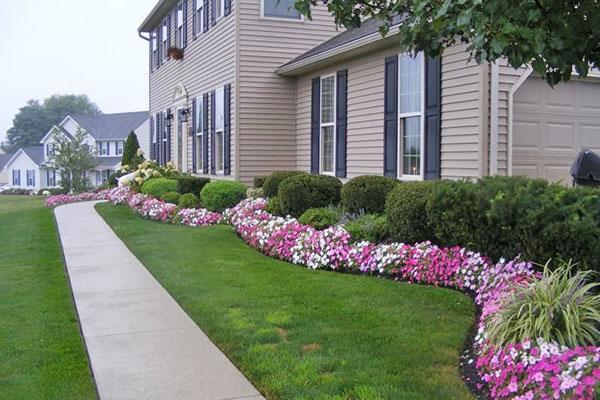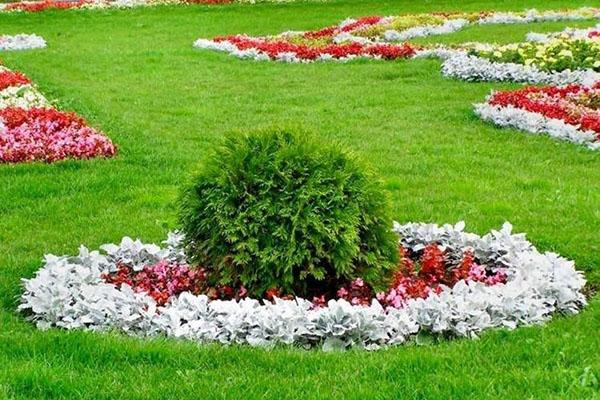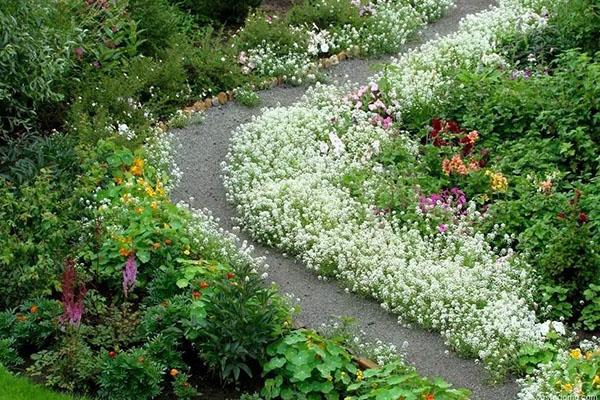Perennial flowers for borders: formation rules
 To isolate and emphasize a flower bed or path, perennial flowers are used for borders. The framing is created up to 50 cm wide - this size is the most optimal for both landscape design and plant care.
To isolate and emphasize a flower bed or path, perennial flowers are used for borders. The framing is created up to 50 cm wide - this size is the most optimal for both landscape design and plant care.
With a relatively small width, the length of the border can be impressive. To obtain the greatest effect, you should correctly approach the selection of plants.
Perennial flowers for borders

Unlike summer plants, plants that do not require complete replacement for several years are more profitable in terms of planting and maintenance.
When choosing perennial border colors, you should be guided by the following characteristics:
- What do they prefer - light or partial shade.
- The ability to fill the designated area.
- Landing height should not exceed 0.5 m.
- Growth intensity. Better to stick with perennial flowers for medium-speed curbs.
- Requirements for conditions and care.
- The ability to maintain its decorative properties under adverse weather conditions and throughout the growing season.
- Fast recovery.
Also important is compatibility with other perennials for the border in plantings.
In the shade, you can plant: astilba, galanthus, periwinkle, brunner, irises, hellebore. In the sun - aquilegia, veronica, heuchera, daffodils, pinnate carnation, tulips. You can plant flowers in the form of a mixborder from plants of different heights.
Low-growing perennial border flowers (photo)
 One of the most valuable characteristics of ground cover crops is the rapid development of the planting site. When they grow, they create a dense flowering carpet.
One of the most valuable characteristics of ground cover crops is the rapid development of the planting site. When they grow, they create a dense flowering carpet.
When framing the path, so that the stems and leaves of flowers do not interfere with free movement, they should be planted, slightly retreating from the edge of the path.
The undersized border flowers include the following.
Arabis
 It takes root from its own shoots, forming a new plant, does not tolerate stagnant melt water and waterlogging.
It takes root from its own shoots, forming a new plant, does not tolerate stagnant melt water and waterlogging.
It grows quickly, therefore constant monitoring is required, shoots are used for breeding. Arabis is good honey plant, therefore, there will be many bees on the plantings during flowering.
In difficult plantings, good companions for rezuha are:
- marigold;
- nasturtium;
- chamomile border;
- calendula;
- alissum.
Flowers lilac, pink, white or yellow are presented in the form of a loose rosette, the leaves are bright green, but there are varieties with and with variegated leaves. Withstands frosts up to 3-5 degrees.
Ayuga
 Ornamental leaves are bright and dark green, blue, purple, burgundy. Lush flowers - blue, blue, purple, yellow.
Ornamental leaves are bright and dark green, blue, purple, burgundy. Lush flowers - blue, blue, purple, yellow.
Loves moisture and shading, but can also tolerate the sun, tolerates mild winters well, shelter is required in severe cold weather.
It spreads over the site due to layering, so you need to monitor the plantings. Self-seeding should not be allowed, since the plants are frail and weak.
The foliage does not shed for the winter, the color remains even under the snow, which is very valuable for plant borders. Has increased resistance to trampling, does not require maintenance and looks great. Combine well with bulbous flowers.
Periwinkle
 Leathery leaves of saturated green color retain their color under the snow, single flowers of violet shades.
Leathery leaves of saturated green color retain their color under the snow, single flowers of violet shades.
The plant prefers shade and partial shade, but tolerates both sun and strong shade. Periwinkle emphasizes the beauty of neighboring flowers, therefore it is often used in mixborders.
Aubrieta
 Loves poor rocky soils, can be planted among stone steps, concrete slabs.
Loves poor rocky soils, can be planted among stone steps, concrete slabs.
Plant height is 15 cm, leaves are green, single flowers of crimson, purple, white or red shade form loose groups. The variety of grades allows you to mix different colors. Good neighbors are: rezuha, phlox, spurge, iris, alyssum.
Low-growing perennials for the border
 From these flowers, you can create a variety of borders that decorate the site.
From these flowers, you can create a variety of borders that decorate the site.
Primrose
 A shade-loving plant with flowers of different shapes and shades. If you combine various hybrids, species and varieties of primroses, you can get a continuously flowering border.
A shade-loving plant with flowers of different shapes and shades. If you combine various hybrids, species and varieties of primroses, you can get a continuously flowering border.
They are good neighbors for any border flowers in the country, as they grow without displacing them, but directing their growth to free space.
The best companions are:
- hosts;
- astilbe;
- ferns;
- miniature conifers.
Primroses prefer moderate, constant soil moisture and diffused shade.
Carnation (dianthus)
 The plant is 20-25 cm high with gray-green erect stems and linear leaves, fragrant flowers of various colors - from white to red.
The plant is 20-25 cm high with gray-green erect stems and linear leaves, fragrant flowers of various colors - from white to red.
There are varieties with double inflorescences. If faded shoots are removed in time, re-flowering is possible. Due to the unusual shade of leaves and stems, the plant looks quite decorative, even when not blooming.
Carpathian bell
 The plant belongs to the border flowers, blooming all summer with blue-violet flowers with a diameter of 2.5 cm. Height is 30 cm, prefers sunny or semi-shaded places, requires fertile and well-drained soil.
The plant belongs to the border flowers, blooming all summer with blue-violet flowers with a diameter of 2.5 cm. Height is 30 cm, prefers sunny or semi-shaded places, requires fertile and well-drained soil.
When the faded shoots are removed, new peduncles are formed, which prolongs the decorative effect of the bell for a long period. Cardinal pruning triggers a second wave of flowering.
In addition to traditional blue shades, depending on the variety, the plant can be with white or pink flowers.
Silvery curb grass
 Plants with silvery leaves perfectly complement and set off the flowers of neighbors.
Plants with silvery leaves perfectly complement and set off the flowers of neighbors.
It is widely used in landscape design, both by professionals and amateurs:
- Silvery-white or bluish-gray pubescent leaves of different varieties of wormwood find a place in the multifaceted mixborder and roadside curb.
- From cypress santolina with its beaded leaves, ideal balls that retain their shape for a long time are obtained when cutting.
- Cineraria seaside has silvery dissected leaves, which are becoming more common in recent years.
In addition to these plants, the Byzantine purse, gray fescue, eremurus, and so on is interesting.
Curb formation rules
 The border should be created from several types of plants so that it is pleasing to the eye throughout the summer.
The border should be created from several types of plants so that it is pleasing to the eye throughout the summer.
Bulbous perennials bloom first in spring - it is better to plant them closer to the path:
- crocus;
- snowdrop;
- hyacinth;
- narcissus;
- tulip.
Ground covers are also suitable - subulate phlox, herbal cloves, periwinkle, mint, basil, thyme.
This is followed by a strip of herbaceous plants that bloom in summer:
- hosts;
- matrix;
- badan;
- dwarf chrysanthemum.
They will cover with their flowering mass the primroses that have departed by that time.
The final strip of the border can be placed undersized flowering shrubs, not exceeding 40 cm in height, so as not to obscure the perspective or flower bed:
- dwarf barberry;
- garden lingonberry;
- rose border;
- Japanese spirea.
When creating a border composition, you need to pay special attention to the selection of colors and shades of plants - in the same range or play of contrasts.In this case, the plants should be planted thickened so that the harmony of the pattern is not interrupted.